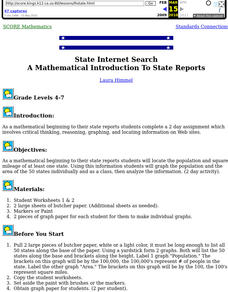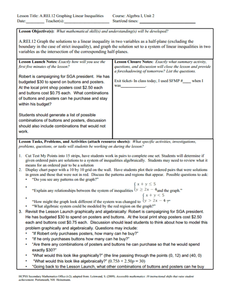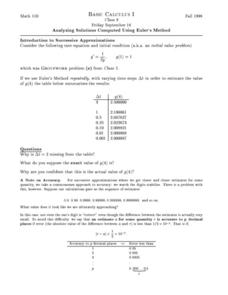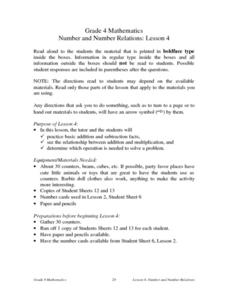Curated OER
The Statue of Liberty -- A Symbol of Freedom
Second graders explore the Statue of Liberty by reading books and internet cites. They must complete a story web
Rainforest Alliance
Knowing the Essential Elements of a Habitat
To gain insight into the many different types of habitats, individuals must first get to know their own. Here, scholars explore their school environment, draw a map, compare and contrast their surroundings to larger ones. They then...
Curated OER
Transformations and Translation of Functions
Students translate functions horizontally and vertically. In this algebra lesson, students identify the parts of the formula that allows the graph to move left, right, up and down. They perform a transformation on the coordinate plane.
Curated OER
State Internet Search: A Mathematical Introduction To State Reports
Students locate the population and square mileage of at least one state. Using this information students graph the population and the area of the 50 states individually and as a class, then analyze the information.
Curated OER
Function Tables
Students practice representing problems found in the real world in terms that can be translated into mathematical expressions. The situations are represented in tables and graphs by students.
Curated OER
I Can Do This! Systems of Equations
Students solve systems of 2-by-2 linear equations using tables,
graphs and substitution. In small groups, classmates work together to discover strategies for solving equations. They use a calculator to graphically represent their answers.
Curated OER
Writing and Solving Equations
Fifth graders explore equations. In this solving equations lesson, 5th graders examine visual examples of writing and solving equations. Students also practice solving problems that their instructors model.
Curated OER
Multiplying Inequalities by Negative
Students multiply inequalities by negative. In this algebra lesson, students solve inequalities and graph their solutions on a number line. They pay close attention to the negative consequence, which causes the sign to flip.
Curated OER
Graphing Linear Inequalities
Eighth graders extend skills for representing and solving linear equations to linear inequalities. Lesson activities build understanding and skill by plotting ordered pairs of numbers that either satisfy or do not satisfy a given...
Curated OER
Fraction Models
Third graders make models of fractions and mixed numbers. Using fraction strips and drawing pictures, 3rd graders develop conceptual understanding of the equivalent forms. Students use the number line to represent and compare...
Curated OER
Multiplication: Building Models, Representations and Explanations
First graders explore multiplication concepts through skip counting, repeated addition and arrays. Using animal characteristics as a context, 1st graders solve problems using mathematical tools such as hundreds charts, number lines, ...
Curated OER
Solving Equations with Variables on Both Sides
In this solving equations worksheet, students solve 15 equations with variables on both sides of the equal sign. Students are encouraged to check all solutions.
Curated OER
Using Inequalities to Problem Solve
Students explore inequalities. In this Algebra I lesson, students solve and graph linear inequalities involving addition, subtraction, multiplication, or division. Students use inequalities to solve and graph real-world problems.
Curated OER
Investigating Quadrilaterals
Fourth graders discuss the various attributes of quadrilaterals. In groups, they use the attributes to sort quadrilaterals into different classes and a hierarchy. They review the new vocabulary and attributes with a partner to end the...
Curated OER
Understanding Radios
Fifth graders explore ratios. Using models and real-world scenarios, they complete tables and generate comparisons. Pupils demonstrate multiple ways of writing ratios and describe the differences between ratios.
Curated OER
Describing Patterns
Fourth graders investigate repeating and growing patterns. Models, graphs and words are used to describe, extend and represent patterns. Students use evidence from models and graphs to support the identification of patterns.
Curated OER
Introduction to Slope Fields
Students plot slope fields. In this introduction to slope fields lesson, students plot 12 slope fields for given differential equations.
Curated OER
Functions As Equations
For this algebra worksheet, students use the given values for the functions to create a pattern of solving an equation that is extended into a word problem.
Curated OER
Variables and Patterns: Determining an appropriate scale while graphing
Sixth graders determine appropriate scales when graphing data. In this graphing instructional activity, 6th graders use an the applet "Graph It" to determine what is an appropriate scale for their data.
Curated OER
Segments and Rays Multiple Choice
In this geometry worksheet, students identify the coordinate pairs of a segment. They calculate the distance using the distance formula. There are 5 questions with an answer key.
Curated OER
Analyzing Solutions Computed Using Euler's Method
In this analyzing solutions worksheet, students use Euler's Method to estimate the value of given functions. They estimate solutions using the piecewise-linear function model and sketch the information onto a graph. This two-page...
Curated OER
Variables and Expressions
In this variables and expressions worksheet, 9th graders solve and complete 19 different problems that include translating various expressions. First, they write a verbal expression for each algebraic expression. Then, students write an...
Curated OER
Open Sentences
In this open sentences worksheet, students solve and complete 10 different problems related to identifying various types of open sentences. First, they state whether each equation is true or false for the value of the variable given....
Curated OER
Number and Number Relations: Lesson 4
Fourth graders investigate the use of addition and subtraction facts in different situations. They examine the relationship between addition and multiplication and determine which operation is needed to solve various problematic situations.























